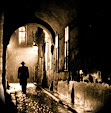
At this point, I think it’s safe to say that Ron Howard is the most innocuous director in Hollywood. The guy doesn’t make bad movies, on the whole, but outside of Apollo 13 he hasn’t made anything truly great, either. Frost/Nixon is yet another workmanlike effort from him, and it might as well be a metaphor for his entire career: It’s well-acted and competently shot, but it’s also frustratingly arbitrary and uninteresting (I can remember few Best Picture nominees that were any less discussed or controversial). Probably the only question raised by Frost/Nixon is why this movie--or, for that matter, the play it's based on--exists at all. Did we really need a dramatization of the famous interviews between David Frost and Richard Nixon, especially when everyone who’s interested in the subject has either already seen the real thing or can easily seek it out? Sure, it’s fun to watch Frank Langella do a Nixon impression, and he does it well, but all the movie as a whole amounts to is a slightly clumsy reenactment of something that most people already know about.
Howard’s way of getting around this issue is to shoot the movie in faux-documentary style, with characters frequently addressing the camera in confessional interviews and recounting their experiences as a part of the two research teams. In addition to just being a tired technique, these interviews also come off feeling like a cheat-- an all too easy way for the film to tell and not show--which ironically breaks the first rule of the kind of “good journalism” that Frost/Nixon is trying to champion. And this is too bad, because the backroom preparation, dealing, and politics that helped make the interviews happen are the only story really worth telling here, and these scenes should have been where the movie really shined. Instead, we get one cliche rolled out after another, where the characters sit around tables littered with papers and coffee cups and name-check all of Nixon’s greatest hits, from the “Checkers speech” to his unfortunate debate with JFK. Outside of this, the movie is also notable for featuring what might be the most half-assed romantic subplot in recent memory, in the form of Frost’s relationship with his girlfriend Caroline, herself a journalist. Why a talented actress like Rebecca Hall would lower herself to playing what amounts to little more than set dressing is completely baffling.
Not surprisingly, the movie only really gains steam when it gets to the unscripted bits: the actual interviews between Frost and Nixon. In what amounts to a real intellectual fencing match, Frost is initially outdone by Nixon, who controls the tone and speed of the interview like the slippery customer that he is, and it’s only when they reach the subject of Watergate that the tables begin to turn. Still, these few exhilarating moments only succeed in highlighting the question that’s hovering over this entire movie: Why watch the recreation of an interview when the real thing is readily available, and now on YouTube, no less? Regrettably, this is a question that Frost/Nixon and its director are never quite able to answer.


